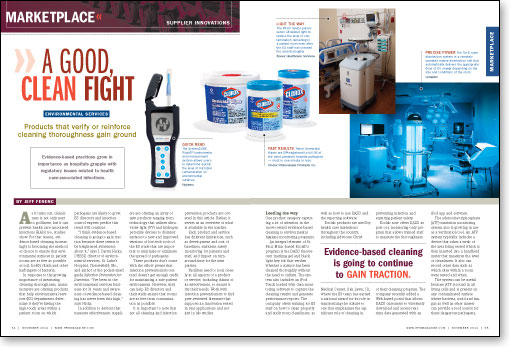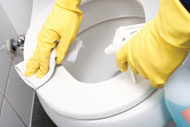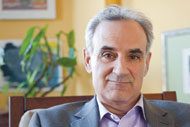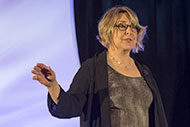
As it turns out, cleanliness is not only next to godliness, but it can prevent health care-associated infections (HAIs) too, studies show. For that reason, evidence-based cleaning increasingly is becoming the method of choice to ensure that environmental surfaces in patient rooms are as free as possible of soil, bodily fluids and other harbingers of bacteria.
In response to the growing importance of measuring cleaning thoroughness, manufacturers are offering products that help environmental services (ES) departments determine if they're hitting the high-touch areas within a patient room on which pathogens are likely to grow. ES directors and infection control experts predict this trend will continue.
"I think evidence-based cleaning is going to gain traction because there seems to be heightened awareness about it," says J. Darrel Hicks, CHESP, director of environmental services, St. Luke's Hospital, Chesterfield, Mo., and author of the pocket-sized guide Infection Prevention for Dummies. "I've been in the environmental services business for 31 years and awareness of evidence-based cleaning has never been this high," says Hicks.
In addition to devices that measure effectiveness, suppliers are offering an array of new products ranging from technology that utilizes ultraviolet light (UV) and hydrogen peroxide devices to disinfect surfaces to new and improved versions of low-tech tools of the ES trade that are important to minimize or eliminate the spread of pathogens.
These products don't come with the elbow grease that infection preventionists contend doesn't get enough credit for maintaining a safe patient environment. However, they can help ES directors and their staffs ensure that rooms are as free from contamination as possible.
It is important to note that not all cleaning and infection prevention products are covered in this article. Rather, it serves as an overview of what is available in the market.
Each product and service has different limitations, such as development and cost of baselines, sufficient safety monitoring for patients and staff, and impact on turn-around-time for the next patient.
Facilities need to look closely at all aspects of a product or service, including claims of its effectiveness, to ensure it fits their needs. Work with infection preventionists to find peer-reviewed literature that supports an innovation tested in real applications and not just in lab studies.
Leading the way
One product category capturing a lot of attention in the move toward evidence-based cleaning is environmental hygiene monitoring programs.
An integral element of St. Paul, Minn.-based Ecolab's program is the DAZO fluorescent marking gel and black light key fob that verifies whether a surface has been cleaned thoroughly without the need to culture. The system also includes an iPod Touch loaded with data monitoring software to capture the cleaning results and generate performance reports. The company offers training for ES staff on how to clean properly and audit room cleanliness, as well as how to use DAZO and the reporting software.
Ecolab products are used by health care institutions throughout the country, including Advocate Christ Medical Center, Oak Lawn, Ill., where the ES team has earned a national award for its role in transforming the culture to one that emphasizes the significant role of cleaning in preventing infection and ensuring patient safety.
Ecolab now offers DAZO as part of a monitoring-only program that allows trained staff to measure the thoroughness of their cleaning program. The company recently added a Web-based portal that allows DAZO customers to wirelessly download and access real-time data generated with an iPod app and software.
The adenosine triphosphate (ATP) sanitation monitoring system also is growing in use as a verification tool. An ATP system typically includes a device that takes a swab of the area being tested which is then inserted into a handheld meter that measures the level of cleanliness. It also can record other data such as which sites within a room were tested and when.
The system can be useful because ATP is found in all living cells and is present on any contaminated surface where bacteria, mold and fungus as well as other matter can provide a food source for these dangerous pathogens, says Hicks. ATP also picks up debris that does not have living cells, but this can be addressed by following product instructions.
Some ATP sanitation monitoring systems feature software to provide managers with a tool to analyze trends and spot potential issues. After the luminometer records the readings, the data is downloaded to a computer for storage.
Jim Topper, market development manager, Neogen Corp., Lansing, Mich., says interest in ATP monitoring is increasing because hospitals and health care facilities are "seeing the link between some HAIs and cleaning. They're placing a renewed focus on equipping their environmental services group with a formal, measurement-based program for evaluating their cleaning effectiveness."
Neogen offers the AccuPoint HC ATP cleaning verification and tracking system, which gets praise from Hicks for the accuracy and consistency of the product's sampler used to swab surfaces for contamination. The product's data manager program allows the user to review the test results by area, room, test site, staff member or date range.
Summary reports with rankings of areas, test sites and staff are also available. A new tool allows users to set performance improvement objectives by a certain date and tracks the performance on a graph.
ATP hygiene monitoring test systems are used in an estimated 25 to 35 percent of hospitals in the United States, which is up from 1 to 5 percent only five years ago, says Steve Nason, director of sales and marketing, Hygiena, Camarillo, Calif., which offers the SystemSURE Plus ATP luminometer.
ATP meters, such as Hygiena's, serve as important training tools and a continuous monitoring system because they can identify areas not cleaned thoroughly and help staff members learn the proper process for cleaning, says Nason.
This enables ES directors and staff to correct the problem quickly, he says.
Hygiena's meter is a small, lightweight device that generates new test results in 15 seconds and stores 2,000 test results overall through the use of a simple menu-driven keypad.
3M Health Care, St. Paul, Minn., offers the Clean-Trace Hygiene Management System, which can assess the cleanliness of a surface and validate cleaning protocols and worker performance in less than one minute.
If the test detects ATP, it will emit light in direct proportion to the contamination level which can be read and quantified by the handheld Clean-Trace NGi luminometer. Data can be uploaded to online software, which provides the users advanced data analysis with tracking and full trending capabilities, including automatic report generation.
Tampa (Fla.) General Hospital is one of about 150 hospitals utilizing the system. John Scolaro, CHESP, director of environmental/textile services, says the ability to confirm cleaning performance by individual touch point and ES staff member has led to improved results.
"The significant improvement from 85 percent to 96 percent in compliance scores can be attributed to the provision of immediate performance feedback and the consequent ability to assess and refine our procedures," Scolaro says.
High-tech disinfection
Though not a replacement for cleaning, new high-tech disinfection systems offer another tool to prevent the spread of pathogens that can result in HAIs. Manufacturers claim that new technology will disinfect those areas within a patient room that staff has failed to clean thoroughly.
One example is the mobile, remotely operated Tru-D SmartUVC Total Room Ultraviolet Disinfection system, which is manufactured by Lumalier, Memphis, Tenn., and available from Philips Healthcare, Andover, Mass.
"Studies have shown that even the most diligent workers are unable to thoroughly clean all surfaces within a room. Tru-D eliminates human error from the cleaning process," says Chuck Dunn, president and CEO, Lumalier.
He says Tru-D is distinct from other UV disinfectant technology because of its "smart UVC." Dunn explains that the machine self-adjusts and delivers the appropriate level of UVC that takes into account variables such as the size of a room, the color of the walls and the content of the room. All surfaces are disinfected in less than 30 minutes, he says.
Xenex Healthcare Services, Austin, Texas, makes a vacuum cleaner-sized disinfection system that emits pulsed xenon UV light like a strobe to kill microorganisms without contact or chemicals in about 10 minutes, according to the manufacturer.
The UV pulse of the lamp penetrates cell walls and creates thymine dimers that fuse the DNA of bacterial spores, viruses and other potentially dangerous organisms, says Mark Stibich, chief scientific officer, Xenex.
Joanne Levin, M.D., medical director, infection prevention, Cooley Dickinson Hospital, Northampton, Mass., says that the hospital began using the Xenex technology after terminal cleaning in January 2011. The hospital experienced a 69 percent drop in its Clostridium difficile (C. diff) rate in the first three quarters of 2011 compared with the first three quarters of 2010, she says.
Fogging or misting devices, as they are sometimes known, represent another room-disinfection option. Glosair Healthcare Environmental Decontamination Systems from Advanced Sterilization Products, Irvine, Calif., creates a fog of hydrogen peroxide that is uniformly dispersed to disinfect all hard, nonporous surfaces, eliminating bacteria and viruses in difficult-to-reach areas, says Utpal Khambholja, M.D., medical officer, Advanced Sterilization Products.
The hydrogen peroxide solution in Glosair is biodegradable, noncorrosive to materials and, when used as directed, safe for patients and equipment. Glosair is intended for areas where it's critical to achieve additional disinfection, which the unit completes in about 2.5 hours, says Khambholja.
"Although cleaning staff are generally conscientious, research indicates that the thoroughness of manual cleaning varies from person to person and from day to day, leaving room for microorganisms to lurk on surfaces," Khambholja says. "Technological advances such as hydrogen peroxide vapor and ultraviolet light for room decontamination have the potential to offer improved thoroughness and greater consistency."
Low-tech but effective
Clorox offers the Germicidal Wipes, an Environmental Protection Agency-registered disinfectant that exceeds the Centers for Disease Control and Prevention-recommended minimum of 5,000 ppm chlorine bleach solution. This enables it to kill 36 of the most prevalent hospital pathogens, including C. diff, says Kim LaFreniere, associate research fellow, Clorox Professional Products Co.
"Clorox Germicidal Wipes are ready-to-use and minimize process error as the premoistened wipes provide the proper concentration of bleach every time they are used, which can simplify training, and reduce the risk of cross-contamination," she says.
Rubbermaid Commercial Products offers an array of microfiber mops and cleaning supplies under the Rubbermaid Hygen Clean Water System brand that are designed to boost efficiency, are versatile and use fewer chemicals and less water compared with traditional mops and buckets.
Rubbermaid's Hygen Clean Water System features an integrated water filter that keeps water and mops cleaner than traditional conventional mop-and-bucket systems. The filter is designed to improve productivity and cut costs by reducing water and chemical usage to create healthier, safer environments.
"Studies have shown that our cleaning solutions remove a high percentage of pathogens, but the tool on its own doesn't properly clean the surface," says Bill Slezak, global director, segment marketing and national accounts, Rubbermaid Commercial Products. "It's a combination of the right tools, the right process, the right training, the right checking."
Though microfiber products cost more upfront than traditional string mops, the savings in water, chemicals and the longevity of the microfiber pads result in a three-month payback, says Jim McBride, health care segment manager, Rubbermaid Commercial Products.
Jeff Ferenc is senior editor for Health Facilities Management.
| Sidebar - For more information |
| For further details on the cleaning and disinfection products in this "Marketplace" article, contact the following vendors: 3M Health Care Advanced Sterilization Products Clorox Professional Products Co. Ecolab Hygiena Lumalier Neogen Corp. Rubbermaid Commercial Products Xenex Healthcare Services |





